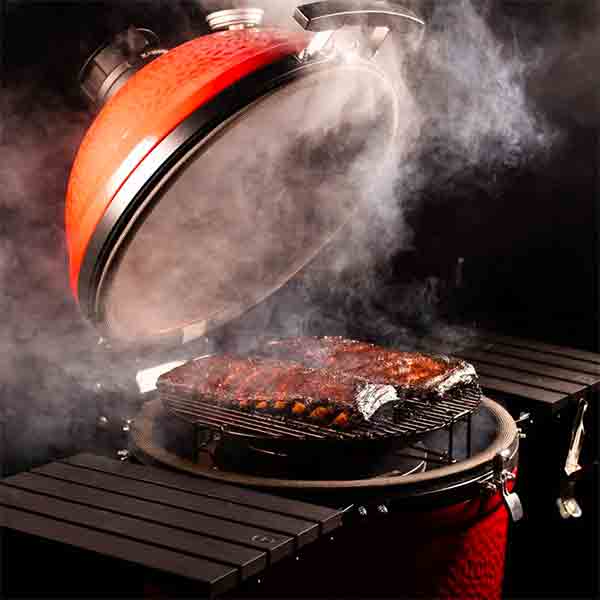The Art of Kamado
FIRE TAMED THE WORLD—
BECAUSE WITHOUT FIRE, THERE IS NO COOKING
Meals began and ended around a fire. Over time, cooking progressed from a simple skewer to a spit to early ovens. These earthenware cooking vessels channeled and controlled the fire’s heat for better flavor. Slowly, the rudimentary cooking vessels evolved around the world, becoming the tandoor oven in India and the charcoal-fueled mushikamado in Japan.
After the Second World War, American soldiers discovered the superior, wood-fired flavor of the kamado and brought the grill home to the States. Since then, the kamado grill has been refined as a versatile ceramic cooker that continues to impress with the incredible flavor and textures it produces. From rich, smoked meat falling apart at the bone to crispy pizzas to juicy, caramelized steaks seared over a hot flame—meals prepared in the kamado taste elemental and true.
Our ancestors understood what we often forget: that time is the best ingredient. Thousands of years ago, people gathered around the kamado while their food cooked; today, despite our sprawling kitchens and double ovens and induction stoves, the kamado is still bringing people together around the fire. More than a way of cooking, kamado is a way of connecting. Connecting with the elements. With our hands, with our food. With the people we love. It’s not fast food. Like any art, it takes time. And the result is a meal that rewards us with unmatched flavor—and the satisfaction of time well spent.
The Fundamentals of Fire
 Fire is the single most important ingredient in successful kamado cooking—and it’s made from just three elements: oxygen, heat and fuel. Learn how to control them, and you’ll know how to control your fire.
Fire is the single most important ingredient in successful kamado cooking—and it’s made from just three elements: oxygen, heat and fuel. Learn how to control them, and you’ll know how to control your fire.
FLAVOR COMES FROM FUEL
Only use premium hardwood lump charcoal to fuel your fire. Combustible liquids (starter fluid, etc.) will impart undesired flavors, damage your grill and create a fire hazard. Remember: flavor comes from your fuel. The taste you put in will eventually come out on your plate.
GOOD FIRE STARTS WITH GOOD AIR FLOW
Add charcoal to the firebox until the mound fills up the firebox halfway. If you’re aiming for high temperatures, you can arrange your charcoal mound for maximum air flow—large chunks on the bottom, smaller pieces to fill in. Now you’re ready to light your charcoal. Fire is a living thing. It needs to breathe a little while before you begin adjusting the temperature, so leave the dome open for about 5 minutes after lighting.
MORE AIR, MORE HEAT–LESS AIR, LESS HEAT
The Kamado Joe’s top and bottom vent system is like a volume dial for your fire. Air moves in the bottom vent and out through the top. Open them to accelerate air flow and ‘turn up’ the temperature; close them to lower it. If you want a hot fire for searing, you’ll need both vents to be mostly open. A low fire for smoking? They should be mostly closed.
CONTROL FROM THE TOP DOWN
The Kamado Joe can achieve temperatures ranging from 225°F to 750°F. It’s easiest to reach and maintain your target temp by setting the bottom vent and adjusting with  the top vent, the Kontrol Tower. For temperatures up to 600°F, adjust the top vent by using just the front slider on the Kontrol Tower. If you are planning to cook at a temperature higher than 600°F, you should also rotate the top of the Kontrol Tower open to increase air flow. To begin, close the dome and keep the front slider all the way open until you are 50°F away from your target temp. Then begin closing the top vent down, wait a minute or two and make necessary adjustments by closing or opening the Kontrol Tower slider more.
the top vent, the Kontrol Tower. For temperatures up to 600°F, adjust the top vent by using just the front slider on the Kontrol Tower. If you are planning to cook at a temperature higher than 600°F, you should also rotate the top of the Kontrol Tower open to increase air flow. To begin, close the dome and keep the front slider all the way open until you are 50°F away from your target temp. Then begin closing the top vent down, wait a minute or two and make necessary adjustments by closing or opening the Kontrol Tower slider more.
GIVE THE FIRE TIME
The biggest mistake you can make is shortchanging your Kamado Joe on time after lighting the charcoal. You get beautiful results from your grill because its ceramic walls absorb, retain and distribute heat like nothing else—but it takes time for those walls to evenly absorb heat. Give your grill 20–40 minutes after lighting to stabilize its temperature before starting your cook. And while you’re working to raise the grill’s temperature, go slowly. Because those ceramic walls retain heat so well, it’s much easier to increase the heat slightly than it is to bring the temperature down after overshooting your target.


